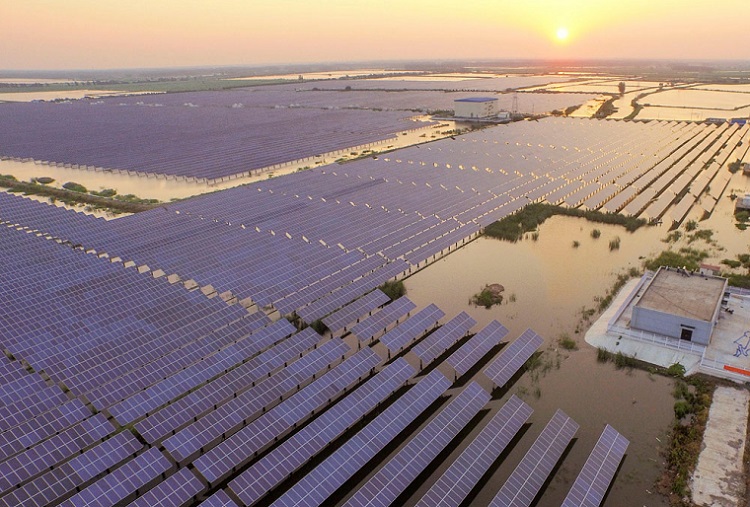


File photo of over-water photovoltaic power panels in East China's Jiangsu.
US President Barack Obama and Chinese President Xi Jinping have just issued a joint statement on climate change that sets out a common vision for the Paris climate agreement to be concluded this December, and which strengthens their respective national climate policies.
China announced that it would launch a national emissions-trading system in 2017 and develop a "green dispatch" system that prioritizes power generation from renewable sources. This follows the recent finalization of the US Clean Power Plan.
China also agreed to contribute $3.1 billion to a bilateral fund to help developing countries fight climate change, consistent with the previously pledged $3 billion for the Green Climate Fund from the US.
The two countries also committed to synchronize the introduction of new heavy-duty vehicle fuel-efficiency standards in 2016, with plans to implement them in 2019. And they will scale up efforts to control emissions of super-warming hydrofluorocarbons.
To strengthen climate action, global corporations depend on strong, harmonized policy signals in the countries where they have operations and supply chains, and this joint announcement by the leaders of the world's two biggest economies sends precisely the signals business needs to act on climate.
This announcement is the latest example of strong cooperation between the US and China on climate change. Last November, the two presidents announced new climate targets for both countries, which have since been submitted for inclusion in the Paris climate agreement. China committed to peaking its carbon-dioxide emissions around 2030 and to increasing the share of energy produced from non-fossil fuels to around 20 percent by 2030.
To achieve this, China will need to install as much renewable energy capacity as the entire US electricity system currently offers. For its part, the US committed to reducing emissions by 26 to 28 percent below 2005 levels by 2025, doubling the pace of reductions currently underway.
The launch of the US-China Climate Change Working Group in April 2013 has led to bilateral cooperation in eight areas, including vehicle-emissions standards, smart grids, energy efficiency, carbon capture and storage, and more.
Earlier this month, the two countries held the first US-China Climate-Smart/Low-Carbon Cities Summit in Los Angeles, where Chinese cities pledged to peak their carbon emissions faster than the national target. Beijing, Guangzhou, and Zhejiang committed to do this by 2020, and Shanghai and Shenzhen pledged to do so by 2022. On the other side of the Pacific, US cities and states have committed to reducing emissions by 80 or more by 2050.
With clear cooperation among national, regional, and local governments in the US and China, now is the time for business to ramp up its climate partnerships.
Last week, Xi's meetings with various prominent US firms emphasize the importance of US-China trade and investment. China's development aspirations rely on innovation, and this is where businesses shine. By working together with government, companies operating in China can green their operations, build climate-resilient supply chains, and scale up low-carbon technologies.
Many companies are already pursuing opportunities to partner with government and with other like-minded businesses.
As a signatory to Obama's American Business Act on Climate Pledge, Apple has pledged to power its global corporate facilities with 100 percent renewable energy. In China, Apple has partnered with SunPower, Tianjin Zhonghuan Semiconductor, and other companies to develop a solar-energy project in Sichuan Province. The project will generate up to 80 million kilowatt-hours of electricity, more than enough to power all of its offices and retail stores in China. By demonstrating the viability of renewable energy, Apple will encourage its suppliers to do the same.
H&M is also investing in renewable energy projects in China. Through its partnership with the Natural Resources Defense Council's Clean by Design program, as well as through H&M's work with RE100, the company is developing innovative solutions to reduce the environmental and climate impacts of its stores and the factors in its supply chain.
Meanwhile, IBM is supporting China's drive to reduce fossil fuels with weather-forecasting technologies and big-data analytics that predict the availability of renewable energy. This will help utility companies minimize energy waste and improve grid stability. IBM's solution has been used in renewable energy projects throughout the country, including in China's largest renewable-energy initiative, the Zhangbei Demonstration Project.
These are but a few examples demonstrating that low-carbon collaboration is big business on both sides of the Pacific. At Business for Social Responsibility, we will be working closely with the We Mean Business coalition and others in the business community from both the US and China to capitalize on the positive momentum policymakers have achieved yet again.

Day|Week

 Stunning photos of air show in China’s V-Day parade
Stunning photos of air show in China’s V-Day parade Bikini models compete in oriental beauty pageant
Bikini models compete in oriental beauty pageant Archaeologists find 4,000-year-old sentry post in Shaanxi
Archaeologists find 4,000-year-old sentry post in Shaanxi Chinese couple claim title for Guinness world's tallest married couple
Chinese couple claim title for Guinness world's tallest married couple Left-behind child faces separation from father after summer vacation
Left-behind child faces separation from father after summer vacation Scenic Liangshan: Photographers' paradise
Scenic Liangshan: Photographers' paradise Amazing China-made flying car expected to serve in the army
Amazing China-made flying car expected to serve in the army Bikini boxing on opening day of a bar in Taiyuan
Bikini boxing on opening day of a bar in Taiyuan Have you met her? Campus belle from Wuhan University
Have you met her? Campus belle from Wuhan University Expert reveals top five longevity acupuncture points
Expert reveals top five longevity acupuncture points